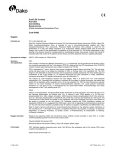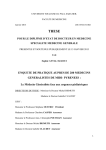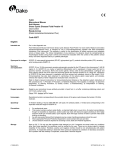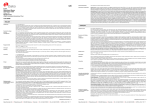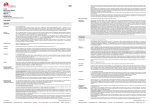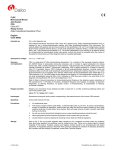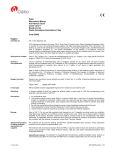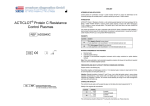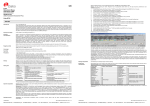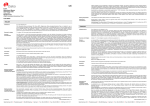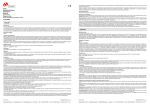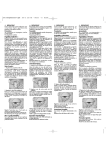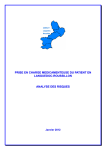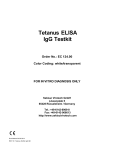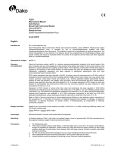Download FLEX Monoclonal Mouse Anti-Human CD7 Clone CBC.37
Transcript
staining pattern is identical to the staining pattern described in “Performance characteristics”. Counterstaining in hematoxylin is recommended using EnVision FLEX Hematoxylin, (Dako Autostainer/Autostainer Plus) (Code K8018). Non-aqueous, permanent mounting medium is recommended. Positive and negative controls should be run simultaneously using the same protocol as the patient specimens. The positive control tissue should include tonsil and the cells/structures should display reaction patterns as described for this tissue in “Performance characteristics” in all positive specimens. The recommended negative control reagent is FLEX Negative Control, Mouse, (Dako Autostainer/Autostainer Plus) (Code IS750). FLEX Monoclonal Mouse Anti-Human CD7 Clone CBC.37 Ready-to-Use (Dako Autostainer/Autostainer Plus) Staining interpretation Cells labeled by the antibody display membrane staining. Performance characteristics Normal tissues: In thymus, the antibody strongly labels lymphoid cells in the medulla and cortex. In lymph node and tonsil, interfollicular T-cell areas are strongly labeled. No labeling is observed in other normal human tissues in which only small T cells are strongly labeled (1). In tonsil, the crowded T cells in the T-zone show a strong staining reaction, whereas isolated T cells in the germinal centers show a moderate to strong staining reaction. Abnormal tissues: Among 110 T-cell lymphomas examined, all T-lymphoblastic lymphomas were strongly positive with the antibody (n=15), while only 25/95 of peripheral T-cell neoplasms were positive. Of note was the diagnostic value of the CD3+, CD7- T-cell phenotype in the diagnosis of lymph node involvement by cutaneous T-cell lymphoma. In Hodgkin’s disease (n=15) of different categories, neoplastic cells were clearly negative and Reed-Sternberg cells were often surrounded by strongly labeled small T lymphocytes. All but one of 35 B-cell lymphomas were negative with the antibody, which labeled only small reactive T cells. Nonlymphoid tumors (n=69) were invariably negative, except for the expected labeling of small reactive T cells (1). Code IS643 ENGLISH Intended use For in vitro diagnostic use. FLEX Monoclonal Mouse Anti-Human CD7, Clone CBC.37, Ready-to-Use, (Dako Autostainer/Autostainer Plus), is intended for use in immunohistochemistry together with Dako Autostainer/Autostainer Plus instruments. CD7 is expressed by the majority of peripheral blood T cells, NK cells, and all thymocytes. This antibody is useful for the identification of T-cell lymphoma (1). The clinical interpretation of any staining or its absence should be complemented by morphological studies using proper controls and should be evaluated within the context of the patient's clinical history and other diagnostic tests by a qualified pathologist. Summary and explanation CD7 is a 40 kDa transmembrane, single-chain glycoprotein belonging to the immunoglobulin superfamily (2). As one of the earliest surface antigens on T- and NK-cell lineages, the presence or absence of CD7 is a useful marker for the classification of T- and NK-cell malignancies. CD7 expression is found on most immature T-cell malignant cells, i.e. acute lymphocytic leukemia (ALL) and T-cell lymphoblastic lymphoma cells. CD7 is also found in NK-cell leukemias, including ALL syndromes that are CD16+, CD56+, and the syndrome of large granular lymphocytosis with malignant CD7+ NK cells (3). The CD7 molecule is absent in a subset of human T cells under certain physiologic and pathologic conditions. Thus, an increase in CD7negative T cells can be seen in some inflammatory skin diseases, and CD7 is absent in a substantial part of mature T-cell neoplasms, especially of primary cutaneous subtype (1). Refer to Dako’s General Instructions for Immunohistochemical Staining or the detection system instructions of IHC procedures for: 1) Principle of Procedure, 2) Materials Required, Not Supplied, 3) Storage, 4) Specimen Preparation, 5) Staining Procedure, 6) Quality Control, 7) Troubleshooting, 8) Interpretation of Staining, 9) General Limitations. Reagent provided Ready-to-use monoclonal mouse antibody provided in liquid form in a buffer containing stabilizing protein and 0.015 mol/L sodium azide. Clone: CBC.37 (1). Isotype: IgG2b, kappa. Immunogen CEM T-cell line (ATCC CCL-199), a T-lymphoblastoid cell line, established from a patient with acute lymphoblastic leukemia (1). Specificity SDS-PAGE analysis of immunoprecipitates formed between CEM cell lysate and the antibody shows that the antibody precipitates a 40 kDa polypeptide corresponding to CD7 (1). Precautions 1. For professional users. 2. This product contains sodium azide (NaN3), a chemical highly toxic in pure form. At product concentrations, though not classified as hazardous, sodium azide may react with lead and copper plumbing to form highly explosive build-ups of metal azides. Upon disposal, flush with large volumes of water to prevent metal azide build-up in plumbing. 3. As with any product derived from biological sources, proper handling procedures should be used. 4. Wear appropriate Personal Protective Equipment to avoid contact with eyes and skin. 5. Unused solution should be disposed of according to local, State and Federal regulations. Storage Store at 2-8 °C. Do not use after expiration date sta mped on vial. If reagents are stored under any conditions other than those specified, the conditions must be verified by the user. There are no obvious signs to indicate instability of this product. Therefore, positive and negative controls should be run simultaneously with patient specimens. If unexpected staining is observed which cannot be explained by variations in laboratory procedures and a problem with the antibody is suspected, contact Dako Technical Support. Specimen preparation including materials required but not supplied Utilisation prévue Pour utilisation lors d’un diagnostic in vitro. FLEX Monoclonal Mouse Anti-Human CD7, Clone CBC.37, Ready-to-Use, (Dako Autostainer/Autostainer Plus), est destiné à une utilisation en immunohistochimie avec les instruments Dako Autostainer/Autostainer Plus. Le CD7 est exprimé dans la majorité des lymphocytes T du sang périphérique, des cellules NK et dans tous les thymocytes. Cet anticorps est utile pour l’identification des lymphomes T (1). L’interprétation clinique de toute coloration ou son absence doit être complétée par des études morphologiques en utilisant des contrôles appropriés et doit être évaluée en fonction des antécédents cliniques du patient et d’autres tests diagnostiques par un pathologiste qualifié. Résumé et explication La CD7 est une glycoprotéine transmembranaire de 40 kDa à chaîne simple appartenant à la superfamille des immunoglobulines (2). Étant l’un des antigènes de surface les plus précoces sur les lignées lymphocytaires T et NK, la présence ou l’absence de la CD7 est un marqueur utile à la classification des tumeurs malignes à lymphocytes T et NK. La CD7 est exprimée sur la plupart des cellules immatures dans les cas de tumeurs malignes à lymphocytes T, c’est-à-dire les leucémies lymphocytaires aiguës (ALL) et les lymphomes lymphoblastiques à lymphocytes T. On trouve aussi la CD7 dans les leucémies à cellules NK, y compris les syndromes de leucémie lymphocytaire aiguë positifs au CD16 et au CD56, et le syndrome de lymphocytose à grands lymphocytes granuleux avec cellules malignes CD7 et NK (3). La molécule CD7 est absente d’un sous-ensemble de lymphocytes T humains dans certaines conditions physiologiques et pathologiques. Ainsi, une augmentation du nombre de lymphocytes T négatifs à la CD7 peut être observée dans certaines maladies cutanées inflammatoires, alors que la CD7 est absente de bon nombre de néoplasmes à lymphocytes T matures, en particulier ceux du sous-type cutané primaire (1). Se référer aux Instructions générales de coloration immunohistochimique de Dako ou aux instructions du système de détection relatives aux procédures IHC pour plus d’informations concernant les points suivants : 1) Principe de procédure, 2) Matériels requis mais non fournis, 3) Conservation, 4) Préparation des échantillons, 5) Procédure de coloration, 6) Contrôle qualité, 7) Dépannage, 8) Interprétation de la coloration, 9) Limites générales. Réactifs fournis Anticorps monoclonal de souris prêt à l’emploi fourni sous forme liquide dans un tampon contenant une protéine stabilisante et 0,015 mol/L d’azide de sodium. Clone : CBC.37 (1). Isotype : IgG2b, kappa. Immunogène Lignée lymphocytaire T CEM (ATTC CCL-199), une lignée cellulaire lymphoblastoïde T, établie à partir d’un patient atteint d’une leucémie aiguë lymphoblastique (1). Spécificité L’analyse par SDS-PAGE d’immunoprécipités formés entre le lysat cellulaire CEM et l’anticorps montre que l’anticorps précipite un polypeptide de 40 kDa correspondant à la CD7 (1). Précautions 1. Pour utilisateurs professionnels. 2. Ce produit contient de l’azide de sodium (NaN3), produit chimique hautement toxique dans sa forme pure. Aux concentrations du produit, bien que non classé comme dangereux, l’azide de sodium peut réagir avec le cuivre et le plomb des canalisations et former des accumulations d’azides métalliques hautement explosives. Lors de l’élimination, rincer abondamment à l’eau pour éviter toute accumulation d’azide métallique dans les canalisations. 3. Comme avec tout produit d’origine biologique, des procédures de manipulation appropriées doivent être respectées. 4. Porter un vêtement de protection approprié pour éviter le contact avec les yeux et la peau. 5. Les solutions non utilisées doivent être éliminées conformément aux réglementations locales et nationales. Conservation Conserver entre 2 et 8 °C. Ne pas utiliser après la date de péremption indiquée sur le flacon. Si les réactifs sont conservés dans des conditions autres que celles indiquées, celles-ci doivent être validées par l’utilisateur. Il n’y a aucun signe évident indiquant l’instabilité de ce produit. Par conséquent, des contrôles positifs et négatifs doivent être testés en même temps que les échantillons de patient. Si une coloration inattendue est observée, qui ne peut être expliquée par un changement des procédures du laboratoire, et en cas de suspicion d’un problème lié à l’anticorps, contacter l’assistance technique de Dako. Préparation des échantillons y compris le matériel requis mais non fourni L’anticorps peut être utilisé pour le marquage des coupes de tissus inclus en paraffine et fixés au formol. L’épaisseur des coupes d’échantillons de tissu doit être d’environ 4 µm. Le prétraitement avec un démasquage d’épitope induit par la chaleur (HIER) est nécessaire. Des résultats optimaux sont obtenus en prétraitant les tissus à l’aide de la EnVision FLEX, Target Retrieval Solution, Low pH (10x), (Dako Autostainer/Autostainer Plus) (Code K8015). Coupes déparaffinées : le pré-traitement des coupes de tissus déparaffinés fixés au formol et inclus en paraffine est recommandé à l’aide du Dako PT Link (Réf. PT100/PT101). Pour plus de détails, se référer au Guide d’utilisation du PT Link. The antibody can be used for labeling formalin-fixed, paraffin-embedded tissue sections. Tissue specimens should be cut into sections of approximately 4 µm. Pre-treatment with heat-induced epitope retrieval (HIER) is required. Optimal results are obtained by pretreating tissues using EnVision FLEX, Target Retrieval Solution, Low pH (10x), (Dako Autostainer/Autostainer Plus) (Code K8015). Deparaffinized sections: Pre-treatment of deparaffinized formalin-fixed, paraffin-embedded tissue sections is recommended using Dako PT Link (Code PT100/PT101). For details, please refer to the PT Link User Guide. Follow the pre-treatment procedure outlined in the package insert for EnVision FLEX, Target Retrieval Solution, Low pH (10x), (Dako Autostainer/Autostainer Plus) (Code K8015). The following parameters should be used for PT Link: Pre-heat temperature: 65 °C; epitope retrieval temperature and time: 97 °C for 20 (±1) minutes; cool down to 65 °C. Remove Autostainer sl ide rack with slides from the PT Link tank and immediately dip slides into a jar/tank (e.g., PT Link Rinse Station, Code PT109) containing diluted room temperature EnVision FLEX Wash Buffer (10x), (Dako Autostainer/Autostainer Plus) (Code K8012). Leave slides in Wash Buffer for 1-5 minutes. Paraffin-embedded sections: As alternative specimen preparation, both deparaffinization and epitope retrieval can be performed in the PT Link using a modified procedure. See the PT Link User Guide for instructions. After the staining procedure has been completed, the sections must be dehydrated, cleared and mounted using permanent mounting medium. The tissue sections should not dry out during the treatment or during the following immunohistochemical staining procedure. For greater adherence of tissue sections to glass slides, the use of Dako Silanized Slides (Code S3003) is recommended. Staining procedure including materials required but not supplied FRANÇAIS The recommended visualization system is EnVision FLEX+, Mouse, High pH, (Dako Autostainer/Autostainer Plus) (Code K8012), replacing the High pH Target Retrieval Solution from this kit with EnVision FLEX Target Retrieval Solution, Low pH (10x), (Dako Autostainer/Autostainer Plus) (Code K8015). The staining steps and incubation times are pre-programmed into the software of Dako Autostainer/Autostainer Plus instruments, using the following protocols: Template protocol: FLEXRTU2 (200 µL dispense volume) or FLEXRTU3 (300 µL dispense volume) Autoprogram: CD7 (without counterstaining) or CD7H (with counterstaining) Suivre la procédure de pré-traitement indiquée dans la notice pour la EnVision FLEX, Target Retrieval Solution, Low pH (10x), (Dako Autostainer/Autostainer Plus) (Code K8015). Les paramètres suivants doivent être utilisés pour le PT Link : température de préchauffage : 65 °C ; température et durée de restauration de l’é pitope : 97 °C pendant 20 (±1) minutes ; refroidiss ement à 65 °C. Retirer le portoir à lames et les lames Autostainer de la cuve du PT Link et plonger immédiatement les lames dans un récipient/une cuve (p.ex., PT Link Rinse Station, réf. PT109) contenant du EnVision FLEX Wash Buffer (10x), (Dako Autostainer/Autostainer Plus) (Code K8012) dilué à température ambiante. Laisser les lames dans le Wash Buffer pendant 1-5 minutes. Coupes incluses en paraffine : comme préparation alternative des échantillons, le déparaffinage et la restauration de l’épitope peuvent être réalisés dans le PT Link à l’aide d’une procédure modifiée. Se référer aux instructions du Guide d’utilisation du PT Link. Une fois que la procédure de coloration est terminée, les coupes doivent être déshydratées, lavées et montées à l’aide d’un milieu de montage permanent. Les coupes de tissus ne doivent pas sécher lors du traitement ni lors de la procédure de coloration immunohistochimique suivante. Pour une meilleure adhérence des coupes de tissus sur les lames de verre, il est recommandé d’utiliser des lames Dako Silanized Slides (Réf. S3003). The Auxiliary step should be set to “rinse buffer” in staining runs with ≤10 slides. For staining runs with >10 slides the Auxiliary step should be set to “none”. This ascertains comparable wash times. All incubation steps should be performed at room temperature. For details, please refer to the Operator’s Manual for the dedicated instrument. If the protocols are not available on the used Dako Autostainer instrument, please contact Dako Technical Services. Optimal conditions may vary depending on specimen and preparation methods, and should be determined by each individual laboratory. If the evaluating pathologist should desire a different staining intensity, a Dako Application Specialist/Technical Service Specialist can be contacted for information on re-programming of the protocol. Verify that the performance of the adjusted protocol is still valid by evaluating that the (117050-002) Dako Denmark A/S IS643/EFG/SSM/2009.06.09 p. 1/4 | Produktionsvej 42 | DK-2600 Glostrup | Denmark | Tel. +45 44 85 95 00 | Fax +45 44 85 95 95 | CVR No. 33 21 13 17 (117050-002) Dako Denmark A/S IS643/EFG/SSM/2009.06.09 p. 2/4 | Produktionsvej 42 | DK-2600 Glostrup | Denmark | Tel. +45 44 85 95 00 | Fax +45 44 85 95 95 | CVR No. 33 21 13 17 Procédure de coloration y compris le matériel requis mais non fourni Le système de visualisation recommandé est EnVision FLEX+, Mouse, High pH, (Dako Autostainer/Autostainer Plus) (Code K8012), remplaçant la High pH Target Retrieval Solution de ce kit avec la EnVision FLEX Target Retrieval Solution, Low pH (10x), (Dako Autostainer/Autostainer Plus) (Code K8015). Les étapes de coloration et les temps d’incubation sont préprogrammés dans le logiciel des instruments Dako Autostainer/Autostainer Plus, à l’aide des protocoles suivants : Protocole modèle : FLEXRTU2 (volume d’application de 200 µL) ou FLEXRTU3 (volume d’application de 300 µL) Programme automatique : CD7 (sans contre-coloration) ou CD7H (avec contre-coloration). Vorbereitung der Probe und erforderliche, aber nicht mitgelieferte Materialien Interprétation de la coloration Les cellules marquées par l’anticorps présentent une coloration membranaire. Caractéristiques de performance Tissus sains : dans le thymus, l’anticorps marque fortement les cellules lymphoïdes de la medulla et du cortex. Dans le ganglion lymphatique et l’amygdale, les zones interfolliculaires des lymphocytes T sont fortement marquées. Aucun marquage n’est observé dans les autres tissus humains normaux dans lesquels seuls les petits lymphocytes T sont fortement marqués (1). Dans l’amygdale, les amas de lymphocytes T dans la zone T présentent une forte coloration alors que les lymphocytes T isolés ainsi que les macrophages dans les centres germinatifs présentent une coloration modérée à forte. Tissus tumoraux : sur les 110 lymphomes à lymphocytes T examinés, tous les lymphomes lymphoblastiques à lymphocytes T étaient fortement positifs à l’anticorps (n=15), alors que seuls 25 néoplasmes à lymphocytes T périphériques sur 95 étaient positifs. La valeur diagnostique du phénotype des lymphocytes T positifs à la CD3 et à la CD7 prend toute son importance dans le diagnostic du rôle joué par le ganglion lymphatique dans le lymphome cutané à lymphocytes T. En observant des cas de maladie de Hodgkin (n=15) de catégories différentes, les cellules néoplasiques étaient clairement négatives et les cellules de Reed Sternberg étaient souvent entourées de petits lymphocytes T fortement marqués. Tous les lymphomes B, à l’exception d’un sur 35, étaient négatifs à l’anticorps qui ne marquait que les petits lymphocytes T réactifs. Les tumeurs non lymphoïdes (n=69) étaient invariablement négatives, à l’exception du marquage attendu des petits lymphocytes T réactifs (1). Die Vorbehandlung gemäß der Beschreibung in der Packungsbeilage für EnVision FLEX Target Retrieval Solution, Low pH (10x), (Dako Autostainer/Autostainer Plus) (Code-Nr. K8015) durchführen. Für PT Link sollten die folgenden Parameter verwendet werden: Vorwärmtemperatur: 65 °C; Temperatur und Zeit für E pitopdemaskierung: 97 °C für 20 (±1) Minuten; auf 65 °C abkühlen. Das Autostainer Objektkträgergestell mit den Objektträgern aus dem PT Link-Behälter herausnehmen und die Objektträger sofort in einen Behälter (z. B. PT Link Rinse Station, Code-Nr. PT109) mit verdünntem, auf Zimmertemperatur gebrachten EnVision FLEX Wash Buffer (10x), (Dako Autostainer/Autostainer Plus) (Code-Nr. K8012) eintauchen. Die Objektträger für 1–5 Minuten im Wash Buffer belassen. Paraffineingebettete Schnitte: Zur Probenpräparation kann für Entparaffinierung und Epitopdemaskierung im PT Link auch ein modifiziertes Verfahren verwendet werden. Weitere Informationen siehe PT Link-Benutzerhandbuch. Nach erfolgter Färbung müssen die Schnitte entwässert, geklärt und mit permanentem Fixiermittel eingedeckt werden. Die Gewebeschnitte dürfen während der Vorbehandlung oder der anschließenden immunhistochemischen Färbung nicht austrocknen. Zur besseren Haftung der Gewebeschnitte auf den Glas-Objektträgern werden Dako Silanized Slides (Code-Nr. S3003) empfohlen. Färbeverfahren und erforderliche, aber nicht mitgelieferte Materialien Das empfohlene Visualisierungssystem ist EnVision FLEX+, Mouse, High pH, (Dako Autostainer/Autostainer Plus) (Code-Nr. K8012), welches die High pH Target Retrieval Solution dieses Systems durch EnVision FLEX Target Retrieval Solution, Low pH (10x), (Dako Autostainer/Autostainer Plus) (Code-Nr. K8015) ersetzt. Die Färbeschritte und Inkubationszeiten sind in der Software der Dako Autostainer/Autostainer Plus-Geräte mit den folgenden Protokollen vorprogrammiert: Matrix-Protokoll: FLEXRTU2 (200 µl Anwendungsvolumen) oder FLEXRTU3 (300 µl Anwendungsvolumen) Autoprogramm: CD7 (ohne Gegenfärbung) oder CD7H (mit Gegenfärbung) Bei Färbedurchläufen mit höchstens 10 Objektträgern sollte der Zusatz-Schritt auf „Pufferspülgang“ eingestellt werden. Für Färbedurchläufe mit mehr als 10 Objektträgern den Zusatz-Schritt auf „Keine“ einstellen. Dies gewährleistet vergleichbare Waschzeiten. Alle Inkubationsschritte bei Raumtemperatur durchführen. Nähere Einzelheiten bitte dem Benutzerhandbuch für das jeweilige Gerät entnehmen. Wenn die Färbeprotokolle auf dem verwendeten Dako Autostainer-Gerät nicht verfügbar sind, bitte den Technischen Kundendienst von Dako verständigen. Die optimalen Bedingungen können sich je nach Probe und Präparationsverfahren unterscheiden und sollten vom jeweiligen Labor selbst ermittelt werden. Falls der beurteilende Pathologe eine andere Färbungsintensität wünscht, kann ein Anwendungsspezialist oder Kundendiensttechniker von Dako bei der Neuprogrammierung des Protokolls helfen. Die Leistung des angepassten Protokolls muss verifiziert werden, indem gewährleistet wird, dass das Färbemuster mit dem unter „Leistungsmerkmale“ beschriebenen Färbemuster identisch ist. Die Gegenfärbung in Hämatoxylin sollte mit EnVision FLEX Hematoxylin (Dako Autostainer/Autostainer Plus) (Code-Nr. K8018) ausgeführt werden. Empfohlen wird ein nichtwässriges, permanentes Fixiermittel. Positiv- und Negativkontrollen sollten parallel zu den Patientenproben und nach demselben Protokoll angefärbt werden. Als positives Kontrollgewebe sollte Mandelgewebe verwendet werden, und die Zellen/Strukturen müssen in allen positiven Proben die für dieses Gewebe unter „Leistungsmerkmale“ beschriebenen Färbemuster aufweisen. Das empfohlene Negativ-Kontrollreagenz ist FLEX Negative Control, Mouse, (Dako Autostainer/Autostainer Plus) (Code-Nr. IS750). DEUTSCH Verwendungszweck Zusammenfassung und Erklärung Zur In-vitro-Diagnostik. FLEX Monoclonal Mouse Anti-Human CD7, Clone CBC.37, Ready-to-Use, (Dako Autostainer/Autostainer Plus) ist zur Verwendung in der Immunhistochemie in Verbindung mit Dako Autostainer/Autostainer Plus-Geräten bestimmt. CD7 wird von den meisten T-Zellen im peripheren Blut, NK-Zellen und allen Thymozyten exprimiert. Dieser Antikörper unterstützt die Identifizierung von T-Zellenlymphomen (1). Die klinische Auswertung einer eventuell eintretenden Färbung sollte durch morphologische Untersuchung mit geeigneten Kontrollen ergänzt und von einem qualifizierten Pathologen unter Berücksichtigung der Krankengeschichte des Patienten und anderer diagnostischer Tests vorgenommen werden. CD7 ist ein einkettiges, transmembranes Glykoprotein mit einem Molekulargewicht von 40 kDa, das zur Superfamilie der Immunglobuline gehört (2). Da es bei Zellen, die von T- und NK-Zellen abstammen, als eines der frühesten Oberflächenantigene auftritt, ist das Vorhandensein bzw. Fehlen von CD7 ein nützlicher Marker für die Klassifizierung von T-Zell- bzw. NK-Zellmalignomen. Eine CD7-Expression wird bei den meisten unreifen, malignen T-Zellen beschrieben, beispielsweise bei der Akuten Lymphatischen Leukämie (ALL) und bei lymphoblastischen TZell-Lymphomen. CD7 findet sich ebenfalls bei NK-Zell-Leukämien wie dem CD16- bzw. CD56-positiven ALL-Syndrom und der grobgranulären Lymphozytose mit malignen CD7-positiven NK-Zellen (3). Unter bestimmten physiologischen und pathologischen Bedingungen fehlt das CD7-Molekül bei einer Untergruppe menschlicher T-Zellen. So wird ein Anstieg der CD7-negativen Zellen bei einigen entzündlichen Hauterkrankungen beobachtet; CD7 fehlt ferner bei zahlreichen Neoplasien aus reifen T-Zellen, insbesondere bei denen des primär kutanen Subtyps (1). Folgende Angaben bitte den Allgemeinen Richtlinien zur immunhistochemischen Färbung von Dako oder der Gebrauchsanweisung für das jeweilige IHC-Detektionsverfahren entnehmen: 1) Verfahrensprinzip, 2) Erforderliche, aber nicht mitgelieferte Materialien, 3) Aufbewahrung, 4) Vorbereitung der Proben, 5) Färbeverfahren, 6) Qualitätskontrolle, 7) Fehlersuche und -behebung, 8) Auswertung der Färbung, 9) Allgemeine Beschränkungen. Geliefertes Reagenz Gebrauchsfertiger monoklonaler Maus-Antikörper, gelöst in einem Puffer, der Stabilisierungsprotein und 0,015 mol/L Natriumazid enthält. Klon: CBC.37 (1). Isotyp: IgG2b, Kappa. Immunogen CEM-T-Zelllinie (ATCC CCL-199), eine T-lymphoblastoide Zelllinie, gewonnen aus einem Patienten mit akuter Lymphoblastenleukämie (1) Spezifität Die SDS-PAGE-Analyse von Immunpräzipitaten, die zwischen CEM-Zelllysat und dem Antikörper gebildet werden, zeigt, dass der Antikörper ein Polypeptid von 40 kDa ausfällt, welches CD7 entspricht (1). Vorsichtsmaßnahmen 1. Nur für Fachpersonal bestimmt. 2. Dieses Produkt enthält Natriumazid (NaN3), eine in reiner Form äußerst giftige Chemikalie. Natriumazid kann auch in als ungefährlich eingestuften Konzentrationen mit Blei- und Kupferrohren reagieren und hochexplosive Metallazide bilden. Nach der Entsorgung stets mit viel Wasser nachspülen, um Metallazidansammlungen in den Leitungen vorzubeugen. 3. Wie alle Produkte biologischen Ursprungs müssen auch diese entsprechend gehandhabt werden. 4. Geeignete Schutzkleidung tragen, um Augen- und Hautkontakt zu vermeiden. 5. Nicht verwendete Lösung ist entsprechend örtlichen, bundesstaatlichen und staatlichen Richtlinien zu entsorgen. Es ist eine Vorbehandlung durch hitzeinduzierte Epitopdemaskierung (HIER-Verfahren) erforderlich. Optimale Ergebnisse können durch Vorbehandlung der Gewebe mit EnVision FLEX Target Retrieval Solution, Low pH (10x), (Dako Autostainer/Autostainer Plus) (Code-Nr. K8015) erzielt werden. Entparaffinierte Schnitte: Die Vorbehandlung entparaffinierter formalinfixierter, paraffineingebetteter Gewebeschnitte sollte mit Dako PT Link (CodeNr. PT100/PT101) erfolgen. Weitere Informationen hierzu siehe PT Link-Benutzerhandbuch. L’étape Auxiliary doit être réglée sur « rinse buffer » lors des cycles de coloration avec ≤10 lames. Pour les cycles de coloration de >10 lames, l’étape Auxiliary doit être réglée sur « none ». Cela confirme des temps de lavage comparables. Toutes les étapes d’incubation doivent être effectuées à température ambiante. Pour plus de détails, se référer au Manuel de l’opérateur spécifique à l'instrument. Si les protocoles ne sont pas disponibles sur l’instrument Dako Autostainer utilisé, contacter le service technique de Dako Les conditions optimales peuvent varier en fonction du prélèvement et des méthodes de préparation, et doivent être déterminées par chaque laboratoire individuellement. Si le pathologiste qui réalise l’évaluation désire une intensité de coloration différente, un spécialiste d’application/spécialiste du service technique de Dako peut être contacté pour obtenir des informations sur la re-programmation du protocole. Vérifier que l’exécution du protocole modifié est toujours valide en vérifiant que le schéma de coloration est identique au schéma de coloration décrit dans les « Caractéristiques de performance ». Il est recommandé d’effectuer une contre-coloration à l’aide d’hématoxyline EnVision FLEX Hematoxylin, (Dako Autostainer/Autostainer Plus) (Code K8018). L’utilisation d’un milieu de montage permanent non aqueux est recommandée. Des contrôles positifs et négatifs doivent être réalisés en même temps et avec le même protocole que les échantillons du patient. Le contrôle de tissu positif doit comprendre l’amygdale et les cellules/structures doivent présenter les schémas de réaction décrits pour ces tissus dans les « Caractéristiques de performance » pour tous les échantillons positifs. Le contrôle négatif recommandé est le FLEX Negative Control, Mouse, (Dako Autostainer/Autostainer Plus) (Code IS750). Der Antikörper eignet sich zur Markierung von formalinfixierten und paraffineingebetteten Gewebeschnitten. Die Stärke der verwendeten Gewebeschnitte sollte ca. 4 µm betragen. Auswertung der Färbung Mit diesem Antikörper markierte Zellen weisen eine Membranfärbung auf. Leistungsmerkmale Gesundes Gewebe: Beim Thymus ist der Antikörper ein wirksamer Marker für lymphoide Zellen in Medulla und Kortex. Bei Lymphknoten und Mandelgewebe werden Bereiche interfollikulärer T-Zellen stark markiert. Keine Markierung wird bei anderen gesunden menschlichen Geweben beobachtet, in denen lediglich die kleinen T-Zellen stark markiert werden (1). In den Mandeln zeigten die eng gepackten T-Zellen in der T-Zone eine starke Färbung, wogegen die isolierten T-Zellen in den Keimzentren eine mäßige bis starke Färbung aufwiesen. Pathologisches Gewebe: Von 110 untersuchten T-Zell-Lymphomen reagierten alle T-lymphoblastischen Lymphome stark positiv mit dem Antikörper (n=15), dagegen waren nur 25 von 95 peripheren T-Zell-Neoplasien positiv. Interessant war der diagnostische Wert des CD3positiven CD7-T-Zell-Phänotyps bei der Diagnose einer Lymphknotenbeteiligung beim kutanen T-Zell-Lymphom. Bei verschiedenen Kategorien von Morbus Hodgkin (n=15) waren neoplastische Zellen eindeutig negativ, während Reed-Sternberg-Zellen oft von stark markierten kleinen T-Lymphozyten umgeben waren. Von 35 B-Zell-Lymphomen reagierten mit einer einzigen Ausnahme alle negativ auf den Antikörper, der nur kleine reaktive T-Zellen markierte. Nicht-lymphoide Tumore (n=69) waren durchgängig negativ, abgesehen von der erwarteten Markierung kleiner reaktiver T-Zellen (1). References/ Références/ Literatur 1. Al Saati T, Alibaud L, Lamant L, Boyes J, March M, Delsol G. A new monoclonal anti-CD7 antibody reactive on paraffin sections. Appl Immunohistochem Mol Morphol 2001;9:289-96. 2. Bowen MA. TC8. CD7 Workshop Panel Report. In: Kishimoto T, Kikutani H, von dem Borne AEG, Goyert SM, Mason DY, Miyasaka M, et al., editors. Leucocyte typing VI. White cell differentiation antigens. Proceedings of the 6th International Workshop and Conference; 1996 Nov 10-14; Kobe, Japan. New York, London: Garland Publishing Inc.; 1997. p. 62-3. 3. Sempowski GD, Lee DM, Kaufman RE, Haynes BF. Structure and function of the CD7 molecule. Crit Rev Immunol 1999;19:331-48. Ex pla nation o f s y mbols/ Explica tion de s s ym bole s/ Erlä uter ung der Sy mbole Aufbewahrung (117050-002) Dako Denmark A/S Bei 2–8 °C aufbewahren. Nach Ablauf des auf dem Fläschch en aufgedruckten Verfalldatums nicht mehr verwenden. Werden die Reagenzien unter anderen als den angegebenen Bedingungen aufbewahrt, müssen diese Bedingungen vom Benutzer validiert werden. Es gibt keine offensichtlichen Anzeichen für eine eventuelle Produktinstabilität. Positiv- und Negativkontrollen sollten daher zur gleichen Zeit wie die Patientenproben getestet werden. Falls es zu einer unerwarteten Färbung kommt, die sich nicht durch Unterschiede bei Laborverfahren erklären lässt und auf ein Problem mit dem Antikörper hindeutet, ist der technische Kundendienst von Dako zu verständigen. IS643/EFG/SSM/2009.06.09 p. 3/4 | Produktionsvej 42 | DK-2600 Glostrup | Denmark | Tel. +45 44 85 95 00 | Fax +45 44 85 95 95 | CVR No. 33 21 13 17 C ata log ue nu mb er Tem pe ratu re li mi ta tio n Use b y Ré fére nc e ca ta lo g ue L imi te s de te mp éra ture Utiliser a va nt Be stel ln umm er Zulässi ge r Te mper a tur be rei ch Verw en db ar b is In vitro diag no stic medi ca l de vic e C on ta in s suffici ent for <n > te sts D isp osi ti f méd ic al d e di ag no stic i n vi tro C on te nu suffis an t p our <n > te sts Ma n ufac tu re r Fa bri ca nt In -Vi tro -D ia gno stiku m Inh al t a usre ic he nd fü r <n> Te sts C on sult i nstru ctio ns for u se Ba tc h co de Vo ir les i nstruc ti on s d’ utilisa ti o n Geb ra uc hsan we is un g be a ch te n Nu mé ro d e lo t (117050-002) Dako Denmark A/S Hers te ll er C ha rge nb eze ic hn un g IS643/EFG/SSM/2009.06.09 p. 4/4 | Produktionsvej 42 | DK-2600 Glostrup | Denmark | Tel. +45 44 85 95 00 | Fax +45 44 85 95 95 | CVR No. 33 21 13 17


